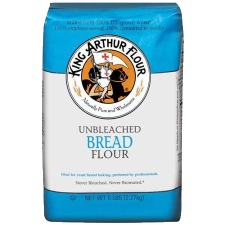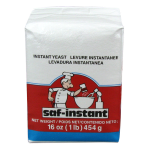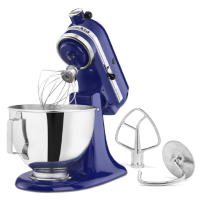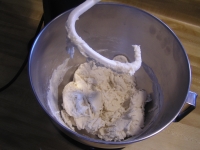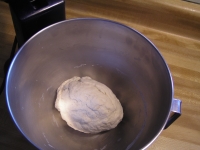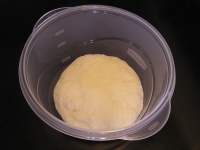Tips & Tricks
Tip #1
Flour is hygroscopic which is a fancy way of saying it can absorb water. Thus, in mid to
late summer flour has a tiny bit more water absorbed in it compared to flour in January or February. I make
a small compensation for this during the year as humidity changes (see Tip #4). Bear in mind this is a perfectionist's
point of view, the adjustment isn't absolutely critical to the outcome.
Tip #2
It may seem obvious, but add yeast AFTER microwaving the water. Yeast is a living organism (it doesn't respond
well to being microwaved). Second, recipes sometimes mix IDY and ADY (Instant and Active Dry Yeast) in with the dry ingredients.
Good idea? Ummm... Maybe... But, understand what's going on here. Both IDY and ADY are freeze dried products. Each tiny grain
of dried yeast is actually a whole city containing millions of yeast cells trapped in the goop the yeast guys eat. Give them a break.
Let them stretch their legs before putting them to work. Afterall, you want them active and throughly dispersed in the dough, not
trapped in their Ho-Ho's and Cheetohs playing video games.
Tip #3
Why wait to add the oil? Well, it's an old baker's trick. Flour absorbs oil faster than water. By wetting the flour first
the dough will be more uniform and clump free. There's a more thorough scientific reason, but let's leave it with "clump free".
Tip #4
Pizza dough is a slightly "slack" dough. This means it has a high water to flour ratio. But, it is
not as slack as, for example, a ciabatta bread. The normal baker's ratio for pizza dough of this
type is 62-65% with flour represented as 100%. Weird, but that is how it's calculated.
The important point is whether your dough has the right "hydration" level. And, that is evident by how
sticky your dough is. Thus, to test the dough, stick your finger into the ball. If a small
residue separates from ball when you pull your finger out, that's good. If the dough ball itself is so
sticky it clings to your hands just handling it, that's bad. The perfect hydration level is when the ball
feels sticky but doesn't cling to your hands and does cling when you do the finger poke test.
Baker's Percent
For those of you familiar with recipes expressed in Baker's Percent, here are the ratios. Very handy to scale the recipe...
| 100 % |
Bread Flour |
| 2.0 % |
Vital Wheat Gluten |
| 2.0 % |
Salt |
| 62.9 % |
Water |
| 0.57 % |
Instant Dry Yeast |
| 3.4 % |
EVOO |


